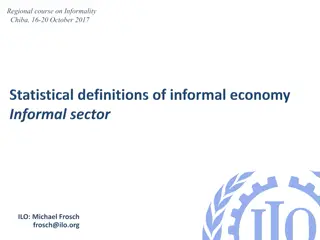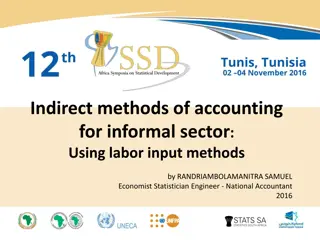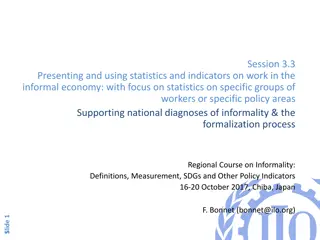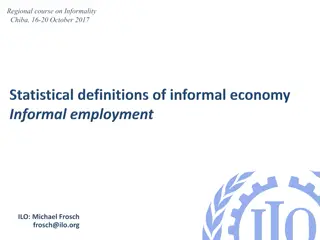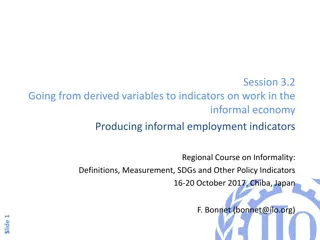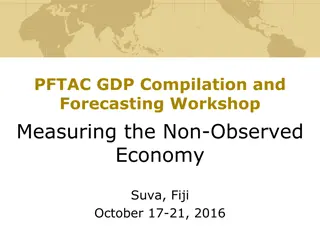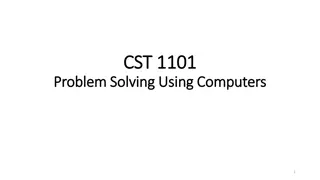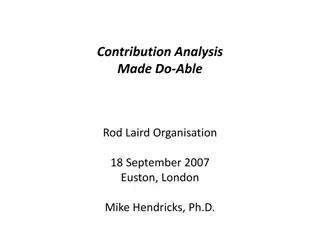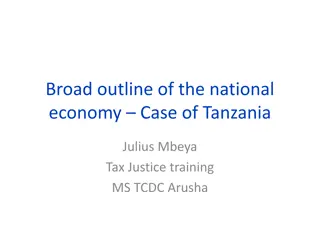Understanding the Informal Economy: Derived Variables and Contribution Analysis
Exploring the significance of the informal sector in national economies, this content delves into the share of informal workers, their GDP contributions, concentration in economic activities, worker categories, geographical distribution, social group concentration, gender differentials, educational and poverty profiles. Statistical indicators and estimation of gross value added are also discussed.
Download Presentation

Please find below an Image/Link to download the presentation.
The content on the website is provided AS IS for your information and personal use only. It may not be sold, licensed, or shared on other websites without obtaining consent from the author. Download presentation by click this link. If you encounter any issues during the download, it is possible that the publisher has removed the file from their server.
E N D
Presentation Transcript
Derived Variables and Contribution of the Informal Economy G.Raveendran
Important National Issues Does informal sector/informal workers constitute a significant share of workers in the country? Do these workers make significant contribution to GDP? Are these workers concentrated in any specific economic activity? Do they belong to any specific categories of workers? Are they located in specific geographical areas? Are they concentrated among specific social groups? Is there any gender differentials in informal sector/informal workers? What is the educational and poverty profile of informal sector/informal workers?
Statistical Indicators A number of statistical indicators are used by the countries to find answers to the above questions. A few of the common indicators are described below: Share of informal sector workers =(Number of informal sector workers/Total workers)*100 Share of informal workers =(Number of informal workers/Total workers)*100
Statistical Indicators (Contd) Share of informal economy workers =(Number of informal economy workers/Total workers)*100 GDP share of informal sector =(GDP contribution of informal sector/Total GDP)*100 GDP share of informal workers =(GDP contribution of informal workers/Total GDP)*100 GDP share of informal economy =(GDP contribution of informal economy/Total GDP)*100 [These indicators can be computed for specific economic activity/sector]
Statistical Indicators (Contd) Gender differential =(Informal women workers/Total women workers)/ (Informal men workers/Total men workers)*100 Incidence of informality by social group =(Informal workers of a specific social group/Total workers of that social group)*100 Incidence of informality by education =(Informal workers of specific educational level/Total workers of that educational level)*100
ESTIMATION OF GROSS VALUE ADDED Total receipts Total operating expenses Distributive expenses, if any Excise duty Sales tax Non-deductible vat Outward freight and transport charges Commission to selling agents, etc. Gross value added= Total receipts - Total operating expenses - Distributive expenses
Total Receipts Value of goods manufactured Value goods sold in the same condition as purchased Changes in the stock of semi-finished products Receipts from services provided to others including commission charges Value of own construction of building, furniture and fixtures Rental received from fixed assets Value of consumption of goods/services produced Funding/donations received excluding capital grants
TOTAL OPERATING EXPENSES Raw materials consumed Purchase value of goods sold in the same condition Electricity charges Fuel and lubricant Raw materials for own construction Rent payable on machinery and building Contract and commission expenses Travelling, freight and cartage expenses Communication expenses
TOTAL OPERATING EXPENSES (Contd) Purchase of consumable stores, packing materials, etc. Purchase value of goods sold in the same condition Paper, printing and stationery Service charges for work done by other establishments License fee, cess charged by local bodies, etc. Minor repair and maintenance of building, furniture, machinery, etc. Other expenses, if any.
SCALING UP Enterprise surveys often underestimates total employment in specific industries due to several reasons including: Invisible enterprises Non-reporting of enterprises by households Under reporting of employment, etc. Scaling up is done by multiplying the estimates of jobs derived from labour force surveys with the average value added per worker derived from enterprise surveys
THANK YOU WIEGO



